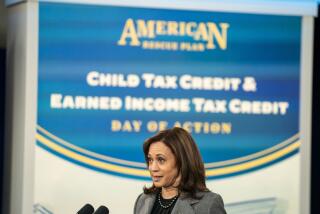House Votes $22.5 Billion in Child Care
- Share via
WASHINGTON — Despite opposition from the Bush Administration, the House Thursday passed a major expansion of federal child care assistance through tax credits and grants to states.
The legislation, which carries a price tag of $22.5 billion over the next five years, was sent to conference committee to reconcile differences with a similar but less costly Senate-approved measure.
It was part of a massive $10.9-billion deficit-reduction bill that cleared the House Thursday by a 333-91 vote. The bill also includes a controversial capital gains tax cut and repeal of the catastrophic health care program. The Senate is expected to adopt its version of a budget reconciliation bill this weekend.
Acting by a decisive vote of 230 to 195, the House rejected an Administration-backed child care plan that would have provided $17 billion, mainly for tax credits, but would not have required any state standards for quality, health or safety. And in an initial test of strength, the House defeated another Republican child care bill that relied entirely on tax credits, 285 to 140.
Under the House rules, the failure of both alternatives leaves intact two separate bills advanced by the Ways and Means Committee and the Education and Labor Committee. Democratic leaders said that the bills would be combined during next week’s negotiations with the Senate into a final version of child care legislation.
Minority Whip Newt Gingrich (R-Ga.) warned that if the measure that emerges from conference committee is unacceptable, however, he would recommend that President Bush veto the bill. “And we have the votes to sustain a veto,” he warned.
Democrats Gain Upper Hand
Rep. Patricia Schroeder (D-Colo.), a longtime advocate of child care aid, declared that Bush tried to steal the issue during the 1988 campaign but that Thursday’s vote gives the Democrats the upper hand in dealing with a critical national problem.
“We have now reclaimed the issue,” Schroeder said. “They didn’t have an issue--they had a fig leaf.”
In rejecting the $17-billion proposal sponsored by Rep. Charles W. Stenholm (D-Tex.), the House majority made clear that it favors minimum standards for training of child care workers and federal health and safety guidelines for care centers.
Majority Leader Richard A. Gephardt (D-Mo.) said that the House would move in conference to drop language in the bill that would bar “any sectarian activity”--a phrase that opponents said would discourage use of religious institutions as child care centers.
The church-state issue has complicated efforts to expand federal child care assistance. Religious institutions are estimated to provide about 30% of these services, and most lawmakers are unwilling to do anything to discourage their participation, despite concerns about the separation of church and state.
The two Democratic plans contained in the House-passed legislation have major differences. However, both would provide two-thirds of the additional aid--or $13.5 billion over the next five years--by enlarging the existing earned income tax credit for poor families with children.
Goes Up With Inflation
This credit, which goes up with the rate of inflation, now provides a maximum of $910 a year for a family with an income between $6,500 and $10,240. As income rises, the credit is reduced by $1 for every additional $10 of pay. It drops to zero for a family making $19,340.
Under the House bill, the maximum tax credit would go up to $1,217 for a family with one child, up to $1,504 for a family with two children, and $1,790 for a family with three children. The credit would be increased by $430 per family for a child under 6 years old.
A family owing no taxes would collect a payment--identical to the amount of the credit--from the federal government.
The Education and Labor plan also would authorize spending $1.75 billion for four programs:
--Expansion of the Head Start program for preschool youngsters to provide daylong care and yearlong services.
--School-based care for early childhood development as well as before-school and after-school care.
--State grants to providers for care of children of low-income and moderate-income families, with an income ceiling of $29,280 for a family of four.
--Separate grants for states to improve the quality of child care through training, licensing and low-interest loans to improve child care facilities.
The Ways and Means plan, in contrast, would channel additional funds for child care through social service block grants to states. It also would assist states that improve standards of care.
The hottest issue in the debate was whether state standards should be imposed on child care providers, including a requirement that workers receive 15 hours of training a year after the program has been in effect for two years.
“Imagine spending government money to train a grandmother how to change a diaper,” complained Rep. Richard T. Schulze (R-Pa.).
“Child care is no longer graham crackers and juice . . . it’s early childhood education,” countered Rep. Jolene Unsoeld (D-Wash.).
Rep. Bill Frenzel (R-Minn.) said that federal spending would rise to $7 billion a year by 1993 under the House bill--an amount that he said is too much.
But Rep. Schroeder said the problem is so severe that the multibillion-dollar amounts are needed.
“California alone has needs so great that all the money in this bill would not close the gap,” she said.
The outcome was a welcome victory for the Democratic leadership, which had suffered a major loss when the House adopted a cut in the capital gains tax advocated by President Bush and opposed by Speaker Thomas S. Foley (D-Wash.).
Staff writer Marlene Cimons contributed to this story.
More to Read
Get the L.A. Times Politics newsletter
Deeply reported insights into legislation, politics and policy from Sacramento, Washington and beyond. In your inbox three times per week.
You may occasionally receive promotional content from the Los Angeles Times.










